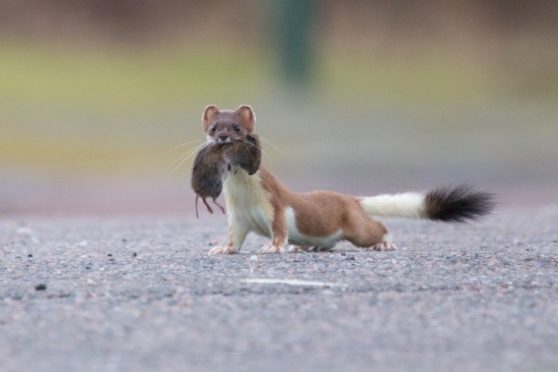A £6million scheme to eradicate stoats from Orkney has now trapped more than 2,600 of the alien invaders – but also continues to catch other species.
It was revealed previously that traps set to wipe out Orkney’s stoat population have inadvertently caught and killed family pets as well as hundreds of other animals.
Pet owners were concerned after four cats were killed and one was injured by the thousands of traps that have been laid since 2017.
But now cull coordinators the Orkney Native Wildlife Project (ONWP) have admitted more non-target animals have been killed, though in decreasing numbers.
Alterations have previously been made to the traps to help minimise such incidents happening.
In its latest update, ONWP said that from October to January 606 stoats were caught – along with an additional 2,600 rats, 33 rabbits, 18 mice, seven frogs, six hedgehots, four voles and three starlings.
The project team said: “There have been 40,426 trap checks in that time so, to set this in context, mice were found during 0.045% of the trap checks.
“The wire-tied entrances to the trap boxes have significantly reduced the numbers of other animals being caught and bycatch continues to fall.
“However, there are occasions when some small animals still find their way into trap boxes but those incidents remain incredibly rare in the context of the large number of traps and trap checks. Nor will these isolated incidents have a significant impact on the overall population of this other wildlife compared to the impact of stoats.”
Project aims to protect Orkney’s native wildlife
The Orkney stoat eradication project is the world’s largest clearance programme of the animal and is run by NatureScot and the RSPB.
It employs around 30 staff at any one time, who work alongside local communities, tourism groups, schools, farmers and land managers.
More than 800 landowners have given permission for the internationally important conservation project, which has trapped and killed 2,683 stoats so far since 2019.
Stoats are native to the UK mainland, but not to Orkney – where they were first reported in 2010 and pose a very serious threat to the local wildlife, such as the Orkney vole, hen harriers, short-eared owls, red-throated divers and many seabirds.
In its latest blog ONWP said: “Since we last reported our trapping statistics in the autumn we have seen a steady increase in the total number of stoats caught.
“This year it is more important than ever to report sightings of stoats across Orkney’s mainland. Stoats are harder to locate when numbers are reduced.
“We also plan to use the specially trained working dogs to methodically check specific areas, which will tell us know whether it is clear of stoats much like they have been doing on the high-risk islands closest to Orkney mainland.
“Alongside the vital stoat sightings from the community, together with monitoring tunnels, motion-triggered cameras, and thermal imaging cameras the dog teams will help track down the last remaining stoats.
“These highly trained working dogs do not hunt stoats, but they do use their noses trained to seek out signs of Orkney stoats and indicate this to their handlers.”
